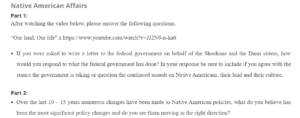Native American Affairs
Part 1
If you were asked to write a letter to the federal government on behalf of the Shoshone and the Dann sisters, how would you respond to what the federal government has done? In your response, be sure to include if you agree with the government is stance or question the continued assault on Native Americans, their land and their culture.
Are you interested in an authentic copy of “Native American Affairs”? Get in touch with us.
I cannot entirely agree with the government’s position in continuing with mining developments in Crescent Valley, Nevada. I support the Western Shoshone’s mission of affirming Newe rights over their homeland by defending, conserving, and restoring their rights for the present and future generations. Preserving their cultural and spiritual traditions is critical to the Newe people (Clemmer, 2009). The American Constitution recognizes that treaties between independent countries mandate the supreme rule of the land. Herein, the 1863 agreement of Ruby Valley between America and the Newe remains intact as it ascertains the sovereign nature of the Western Shoshone and identifies their territorial boundaries (Clemmer, 2009). The federal government intended to preserve cultural sites and water resources when making this treaty. However, Canadian private organizations like Oro Nevada continue to purchase and mine within the Newe homeland while violating the American Constitution and the Ruby Valley Treaty. Presently, Barrick Gold, a private entity, encroaches on this territory by digging one of the enormous open gold mines pit in America on the areas of Mount Tenabo.
Mary and Carrie Dann, on behalf of the Western Shoshone elders, challenged the U.S. administration over concerns about their tribal land. In my perspective, no price can match the value of Western Shoshone lands since they represent people’s heritage, a sense of belonging, and homes to current and future generations. The 1985 Supreme Court ruling awarded $26 million for Western Shoshone payment was not just as it was forcibly executed, disregarding the majority of votes against the financial settlement (Clemmer, 2009). The Natives occupying the land require the American government to respect the tenets of the 1863 agreement. The active movement by the Danns played a huge role in fighting against racial discrimination, the right to own their land, and the government to recognize their sense of belonging factor (Clemmer, 2009). Regardless of U.N. mandating the U.S. administration to stop all actions against the Newe people, America continues to ignore it.
Part 2:
Over the last 10 – 15 years, numerous changes have been made to Native American policies; what do you believe have been the most significant policy changes, and do you see them moving in the right direction?
The Department of Justice Sovereignty Policy has been among the most significant changes in Native American affairs. The policy emphasizes Native’s independence and government-to-government dealings with indigenous communities; it also seeks to endorse the government’s recognition of the independent status of the federally identified native tribes. It assures them that the DOJ is developing working relationships with the federally identified Indian communities (Clinton, 1994). This policy guides the department in its obligations in Indian affairs. Since ancient times, America has continued to recognize the independent status of the native communities as domestic dependent countries (Clinton, 1994). Furthermore, it classifies Indian agreements with the government as the absolute law of America and establishes indigenous affairs as a distinctive sector of national concern.
Over a decade ago, America pledged to defend Indian communities by establishing the basis for the administration’s trust obligation in the government-to-government associations with the native tribes. Up to date, these principles continue to instruct U.S. policies toward the Indian communities. A historic meeting 1994 between tribal elders and President Clinton reassured America’s responsibility to establish a unique legal relationship with the Indian administrations (Clinton, 1994). The president issued a directive to government departments requiring operations affecting Native’s ethnic rights to be executed in a skillful and thoughtful means that respects tribal rule (Clinton, 1994). However, following the procedural actions by the government, I do not see these policies moving in the right direction. These written laws lack implementation by the federal government. Seemingly, the U.S. administration dishonours government-to-government relationships with the sovereign native tribes.
Other Related Post: Aaron Feuerstein Case Study
References
Clemmer, R. O. (2009). Land rights, claims, and western Shoshones: The ideology of loss and the bureaucracy of enforcement. PoLAR: Political and Legal Anthropology Review, 32(2), 279-311.
Clinton, W. J. (1994). Department of Justice Policy on Indian Sovereignty and Government-to-Government Relations with Indian Tribes. Executive Memorandum.
Oxfam America, 2008. Our Land, Our Life. Available at: <https://www.youtube.com/watch?v=JJ2N9-n-ka0> [Accessed 21 August 2020].
ORDER A PLAGIARISM-FREE PAPER HERE
We’ll write everything from scratch
Question
Native American Affairs
Part 1:
After watching the video below, please answer the following questions.

Native American Affairs
“Our land, Our life” a https://www.youtube.com/watch?v=JJ2N9-n-ka0
- If you were asked to write a letter to the federal government on behalf of the Shoshone and the Dann sisters, how would you respond to what the federal government has done? In your response, be sure to include if you agree with the government is stance or question the continued assault on Native Americans, their land and their culture.
Part 2:
- Over the last 10 – 15 years, numerous changes have been made to Native American policies; what do you believe have been the most significant policy changes, and do you see them moving in the right direction?

